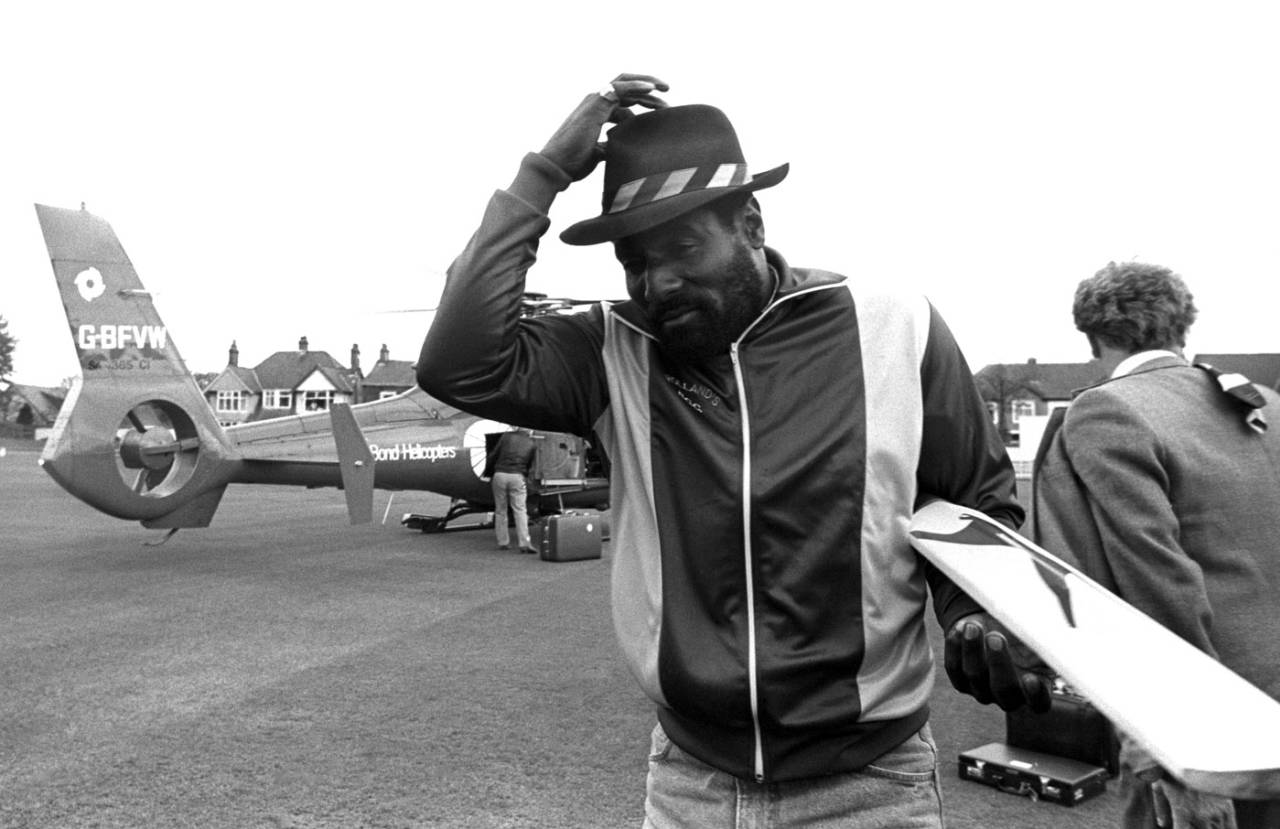Bioengineering the supercricketer
Whose DNA strands do you need to combine to make the ultimate allrounder?
Nicholas Hogg
12-Jun-2015

For style and substance, we need look no further than Viv • PA Photos
Dr David Bacon rested my battle-damaged cricket bat on the table and began his examination of my wounded favourite. Three seasons old, a hitter of nearly 50 sixes, with cracks taped over and chipped edges, she was showing signs of injury - one corner of the toe had been whittled away by tapping out leg-stump guards on dusty wickets, and the face, fatally, as Dr Bacon would gravely explain, had delaminated. This medical cricket bat term, explained to me gently by the good doctor, meant that the middle had gone.
The bat, the sprung willow that had launched balls out of grounds, could not be saved. However, as Dr Bacon explained, in the lab of B3 Cricket - well, a bustling workshop in an industrial estate on the edge of Nottingham - it could be replicated using a bespoke "bat-mapping" process that overlaid a digital grid over the blade to detect its particular contours.
"A replicant," I pondered, and then imagined, in a way that only an overthinking novelist would. In Ridley Scott's Blade Runner the replicants were bioengineered androids with superior strength and agility. Although Dr Bacon quickly pointed out that it would be no superbat, simply a replication of my previous beloved - which in my biased opinion was a superbat - my brain was whirring.
What if strands of cricketers' DNA could be grafted and entwined into a single being, producing the ultimate player? In Jurassic Park the extinct dinosaurs are resurrected by DNA found in mosquito's blood preserved in amber. On this wobbly premise, legends of cricket past could also be revived in the limbs of a supercricketer.
The first name that comes to mind is one I'd not have on the list. I understand this might be controversial - as would the morality of this very experiment - but as I want this Frankenstein's monster of a player to be a star of cricket now, I'm afraid I'd leave Don Bradman's DNA where it rests. I know he was a genius, and I know the stats speak for themselves, but would he have lit up T20 games with blazing hitting displays?

No courage like Brian Close's•The Cricketer International
I'd rather have Sir Vivian Richards' supreme timing DNA for the limited-overs arena. If that included his confidence at the crease, it would be a bonus. Perhaps his bravery too, considering the footage of Dennis Lillee's six balls (including four lethal bouncers) I recently came across from the 1976 Gillette Cup semi-final between Western Australia and Queensland. As tempting as it would be to take a good chunk of Viv's cricket genes for sheer heroism too, I'd have to insert a strand of Yorkshire steel and some of the grit of Brian Close. His punchbag body took ball after ball from Michael Holding in 1976, and the helmetless Close never rubbed a blow. With his courage grafted into my supercricketer, no fast bowler would ever intimidate.
Toughness and timing also need cunning and creativity. For sheer wizardry of strokeplay, field placing and captaincy, the man of the moment must be Brendon McCullum. Some of his fielding traps resemble abstract art, and although commentators seem forever entertained and curious at his bizarre choreography, there is always method to McCullum's seeming madness. If I could swipe DNA also from Jos Buttler, Glenn Maxwell and AB de Villiers, then my batting replicant's wagon wheel from his inevitable super innings would have spokes reaching to every point of the boundary. They have all torn up the coaching manual and rewritten their own rules about how to bat.
To timing, fearlessness, and entrepreneurial hitting, we should add a little power. And here there is only one strand of DNA required - Chris Gayle. Three days ago Tom Cary of the Telegraph interviewed Gayle during a six-hitting contest with his pal, Kevin Pietersen. "Hospital" and "Burial Ground", I discovered, were the names given to his biceps. In a six-distance challenge against KP, he cracked a ball 119 metres. With Gayle muscle packed into my cricketing replicant, no boundary in world would be big enough to contain his hitting.

Shane Warne: wizard with ball and spoken word•Getty Images
With the batting genetics engineered, we should look to bowlers, so the android can turn his arm over when needed. Top of the DNA pile for destructive pacemen has to be Malcolm Marshall. With swing, speed and control, he is constantly judged by other icons as the best quick who ever took the field. I might add a dash of Wasim Akram for the uncanny knack of yorking, as well as the raw force of Frank "Typhoon" Tyson, whom the Don described as the "fastest bowler I've ever seen".
Even a vicious paceman can be nullified on a benign track, so a spin king's DNA should also be used for those fifth-day turners. We'll keep this simple and stick to one man's legspin: Shane Warne's. Not only does Warne DNA come with the full range of wristspin weaponry but the added bonus of first-class sledging. An acid wit to unnerve the most focused batsman is a skill unto itself, and few were better than Warne at cracking gags to break concentration.
Finally, and simply, a strand of Jonty Rhodes for the fielding. Along with perhaps the most important gene of all: the will to win. Controversial, perhaps, but Douglas Jardine's genes would ensure that in every game the replicant played, only victory would suffice.
Thankfully replicating a favourite bat is a lot simpler than bioengineering the ultimate cricketer.
Nicholas Hogg is a co-founder of the Authors Cricket Club. His first novel, Show Me the Sky, was nominated for the IMPAC literary award. @nicholas_hogg